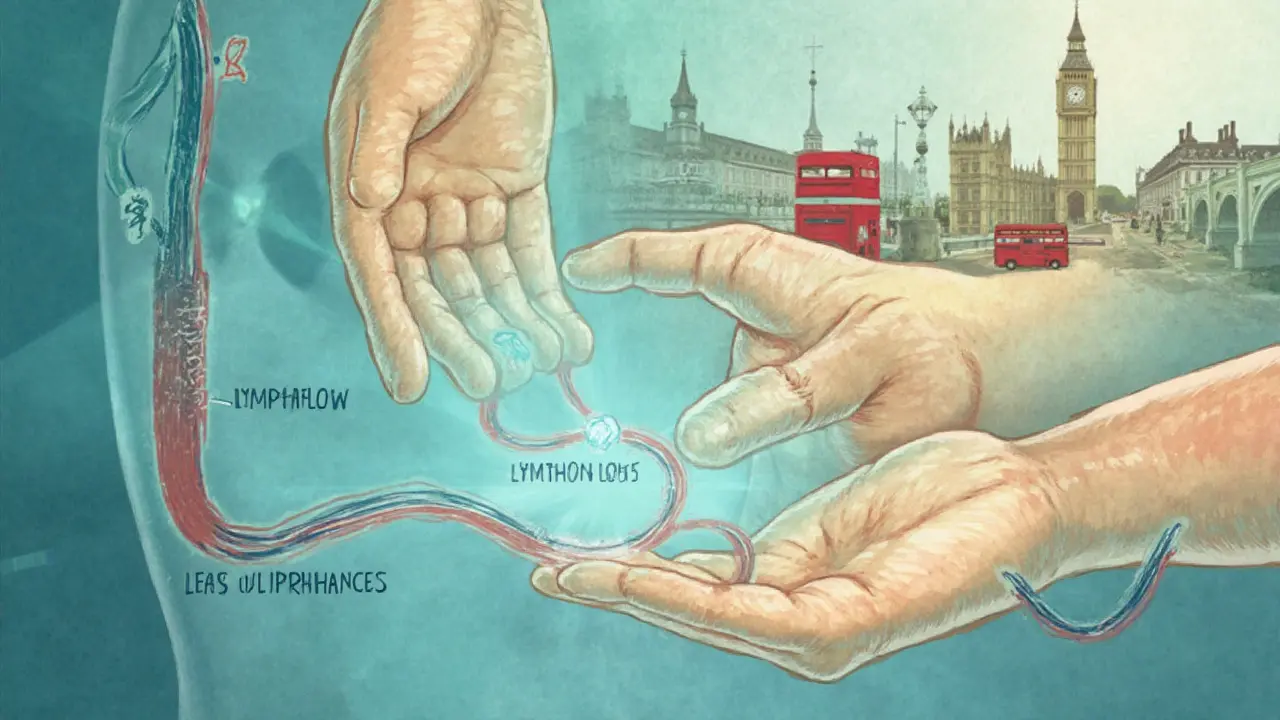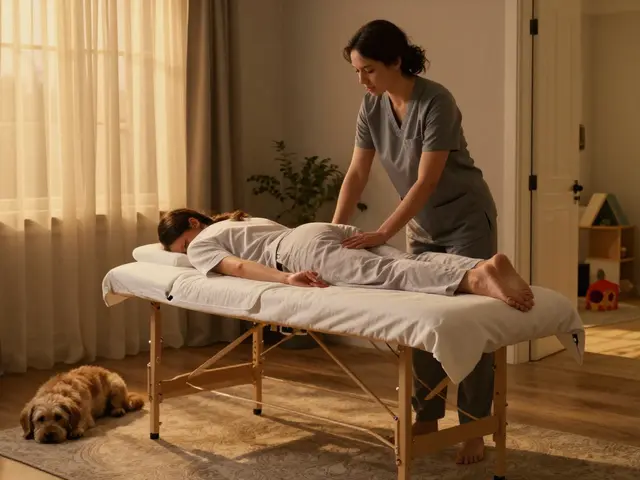Swelling and discomfort after surgery can slow anyone down. While ice packs and rest are standard advice, not everyone knows that lymphatic drainage massage can actually make a big difference in healing.
This isn’t your average back rub. Lymphatic drainage massage uses gentle movements aimed at kick-starting your lymphatic system. That’s the part of your body responsible for clearing out waste and extra fluid—think of it as your inner clean-up crew. After surgery, your lymph flow can back up, leading to puffiness and soreness that just won’t quit.
For folks who’ve had cosmetic surgery, orthopedic procedures, or cancer treatments, doctors often recommend this massage to speed up recovery. Ever notice how some people bounce back from surgery faster than others? A big part of that is managing swelling, and this technique tackles it head-on. It’s safe, usually pretty relaxing, and, best of all, can cut down on that uncomfortable "post-op bloat."
Before booking your first appointment or trying it yourself, there are a few things to keep in mind to make sure it’s safe and worth your time. This isn’t a DIY job for everyone, especially if you have medical conditions like heart problems or blood clots. But for most people, with a green light from their doctor, it’s a game changer.
- What is Lymphatic Drainage Massage?
- Why Recovery Needs More Than Rest
- What Really Happens During a Session
- Tips for Best Results
What is Lymphatic Drainage Massage?
Lymphatic drainage massage is a hands-on technique built to help your lymphatic system do its job. The main purpose is to push lymph fluid—a clear fluid that carries waste, toxins, and immune cells—through your body so it doesn’t get stuck anywhere. When fluid pools up, you get swelling, discomfort, and a higher risk of infection. This massage aims to stop that from happening.
Here’s what makes it different from a regular massage: it uses slow, light strokes, never deep pressure. The reason is simple—lymph vessels sit right under your skin, so you don’t need to dig deep. The therapist follows the natural flow of lymph, directing it toward your body’s drainage points (like your neck, armpits, and groin).
Lymphatic drainage was first developed in Europe in the 1930s, but it’s gained real traction in modern clinics, especially for people recovering from surgery or dealing with stubborn swelling (that’s called lymphedema). Experts, like nurses and physical therapists, are now trained in these techniques for post-op care. A study in the journal "Plastic and Reconstructive Surgery" (2021) found that patients getting this massage after cosmetic surgery had less swelling and healed faster than those who skipped it.
Some folks try to do a version of this at home, but it’s easy to miss the mark if you don’t know the right moves—or if you push too hard. If you want to try it, look for a certified lymphatic drainage therapist. They’ll know how to focus on the swollen areas and use moves that actually help rather than just rub the skin.
The most important thing to remember: lymphatic drainage isn’t just about comfort. It’s a real tool with proven benefits for healing, especially after surgery. If your doctor suggests it, chances are it can help you bounce back faster, with less downtime and less pain.
Why Recovery Needs More Than Rest
Kicking your feet up after surgery helps, but it doesn’t handle everything your body has to deal with. Staying still for long stretches slows down circulation and messes with your lymphatic system, which is in charge of flushing out fluid and waste. This can cause swelling, bruising, and that heavy, uncomfortable feeling people talk about.
After surgery, your lymph system is like a traffic jam—fluid builds up because it can’t move fast enough. Doctors call this post-surgical lymphedema, and it’s not just annoying. If fluid hangs around too long, it can slow down healing, pull at stitches, and even raise your risk for infection. A study from the American Journal of Physical Medicine & Rehabilitation found that patients who got regular lymphatic drainage massages had up to 30% less swelling by the third week compared to those who only rested.
Check out this table showing common recovery concerns and how lymphatic drainage can help:
| Recovery Problem | What Lymphatic Drainage Massage Does |
|---|---|
| Swelling (Edema) | Moves extra fluid out faster |
| Bruising | Breaks down pooled blood under the skin |
| Slow Healing | Increases nutrient flow to damaged tissue |
| Pain or Soreness | Reduces pressure and tension around nerves |
| Scarring | Helps skin and tissue knit together smoothly |
No one wants to drag out recovery longer than necessary. The key is to pair rest with techniques that get your body working again. Walking, light stretching, and targeted massage help your lymph system do its job rather than leaving it stuck in park.
Just icing and “taking it easy” doesn’t always cut it. Lymphatic drainage massage gives your system the push it needs so you can get back to your normal routine, whether that’s chasing a pet around the house or just heading back to work faster.

What Really Happens During a Session
Walking into a lymphatic drainage massage session, you’ll notice pretty quickly that it doesn’t feel like your typical spa massage. You stay on a comfy table, and the room is usually quiet to help you relax. But here’s the real difference: the therapist uses very light, rhythmic strokes with their hands—nothing deep or painful. They’re following the pathways of your lymph system, starting closest to the neck and moving toward the affected areas. This helps move fluid from swollen spots back toward the heart, where the body can process and get rid of it more easily.
During the session, you might notice the therapist using slow circular movements or tiny pumps with their fingers. These motions are planned out to help your lymphatic system do its job better and faster. Don’t expect oils or lotions—it’s usually done dry, since creams can sometimes slow down their movements.
Here’s a quick breakdown of what usually happens:
- First, the therapist checks for swelling and asks about your surgery, scars, and how you’re feeling.
- They start with lymph nodes around your neck and collarbone, because clearing these "main drains" makes it easier for fluid lower down to move out.
- The therapist works down the body in a specific order, using gentle movements on your skin in the direction of lymph flow.
- If you’ve had surgery on your legs or tummy, you’ll notice extra attention to those areas. After breast or facial surgery, they’ll focus around your chest and head.
- A session usually lasts 30 to 60 minutes, and you stay mostly covered up to keep warm.
Most people feel relaxed during the massage and sometimes even need to pee afterward—yep, that’s the fluid getting processed out. It’s totally normal. If anything feels uncomfortable, tell your therapist right away. The goal here isn’t to dig deep but to get your lymphatic drainage system back on track.
Some folks even notice less swelling after just one session, but a full recovery usually takes a few visits. Your therapist or doctor will help set up a plan that works for your specific surgery and body.
Tips for Best Results
If you want to get the most out of lymphatic drainage massage after surgery, there are a few tricks that make a real difference. First, timing matters. Most plastic surgeons and physical therapists recommend waiting for stitches to be removed and wounds to be mostly healed before you book a session. For common procedures like liposuction or knee surgery, this can be anywhere from a few days to two weeks—always ask your doctor first.
Hydration is huge. Your lymphatic system needs water to flush out fluid, so drinking plenty of water right after each session isn’t just a good idea, it’s a must. Try to keep a water bottle nearby and sip throughout the day, not just when you’re thirsty.
- Wear loose, comfortable clothes after a massage. Tight outfits can slow down fluid movement.
- Get moving, if your doctor says it’s safe. Even short walks help the lymphatic system work better.
- Avoid heavy meals and salty foods, which can add fluid retention.
- Stick to the schedule. Most people see real improvements after multiple sessions—once a week is the standard, but some folks start with two to three times in the early weeks after surgery.
Another insider tip: don’t skip compression garments if your surgeon suggests them. They boost the effects of the massage and keep swelling down. Keep them clean and properly fitted for best results.
Choose your therapist carefully. Make sure they’re trained in lymphatic drainage—this is not your normal deep tissue massage. Look for someone with experience helping post-surgery clients. If you’re unsure, ask your doctor or check with local clinics that work with surgical patients.
One big myth is that harder pressure means better results. That’s not true with lymphatic drainage. Gentle, rhythmic movements are what help move fluid, not digging deep into tissue. If it hurts, it’s done wrong—or it’s the wrong technique altogether.
Finally, listen to your body. Some soreness and tiredness is normal after the first session. If you get fever, redness, or severe pain, talk to your doctor. Those could be signs of infection, not standard side effects.





